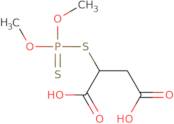Malathion diacid
CAS: 1190-28-9
Ref. 3D-FM24975
| 1g | Discontinued | ||
| 25mg | Discontinued | ||
| 50mg | Discontinued | ||
| 100mg | Discontinued | ||
| 250mg | Discontinued | ||
| 500mg | Discontinued |
Product Information
- 2-[(Dimethoxyphosphinothioyl)thio]butanedioic acidMercapto-O,O-dimethyl phosphorodithioate succinic acid2-[(Dimethoxyphosphorothio yl)sulfanyl]succinic acid
- 2-[(Dimethoxyphosphinothioyl)thio]butanedioic acid
- 2-[(Dimethoxyphosphorothioyl)Sulfanyl]Butanedioic Acid
- 2-[(Dimethoxyphosphorothioyl)sulfanyl]succinic acid
- Butanedioic acid, 2-[(dimethoxyphosphinothioyl)thio]-
- Butanedioic acid, [(dimethoxyphosphinothioyl)thio]-
- Malathiondicarboxylic acid
- Maldison Dicarboxylic Acid
- O,O-Dimethyl S-(1,2-dicarboxyethyl) phosphorodithioate
- Phosphorodithioic acid, O,O-dimethyl ester, S-ester with mercaptosuccinic acid
- See more synonyms
- Succinic acid, mercapto-, O,O-dimethyl phosphorodithioate
- Succinic acid, mercapto-, S-ester with O,O-dimethyl phosphorodithioate
Malathion diacid is a chemical compound that is used in the preparation of biological samples for analysis. It has been shown to have a high degree of specificity for the detection of endometriosis. Malathion diacid has also been used in animal studies to determine its effects on protein synthesis and diethyl succinate, which is an organic compound that can be found in urine samples. Malathion diacid has been shown to inhibit fatty acid metabolism and may have health effects on women when it is ingested through food. It also inhibits the methylation of proteins by inhibiting protein synthesis, which may lead to an increase in urea nitrogen levels.





